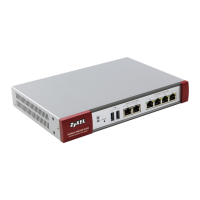ZyWALL USG 100/200 Series User’s Guide
291
CHAPTER 13
Interfaces
13.1 Interface Overview
Use the Interface screens to configure the ZyWALL’s interfaces. You can also
create interfaces on top of other interfaces.
• Ports are the physical ports to which you connect cables.
• Interfaces are used within the system operationally. You use them in
configuring various features. An interface also describes a network that is
directly connected to the ZyWALL. For example, You connect the LAN1 network
to the LAN1 interface.
• Zones are groups of interfaces used to ease security policy configuration.
13.1.1 What You Can Do in this Chapter
•Use the Port Role screens (Section 13.2 on page 295) to create port groups
and to assign physical ports and port groups to Ethernet interfaces.
•Use the Ethernet screens (Section 13.3 on page 296) to configure the Ethernet
interfaces. Ethernet interfaces are the foundation for defining other interfaces
and network policies. RIP and OSPF are also configured in these interfaces.
•Use the PPP screens (Section 13.4 on page 307) for PPPoE or PPTP Internet
connections.
•Use the Cellular screens (Section 13.5 on page 314) to configure settings for
interfaces for Internet connections through an installed 3G card.
•Use the WLAN screens (Section 13.6 on page 323) to configure settings for
interfaces on a wireless LAN card.
•Use the VLAN screens (Section 13.8 on page 338) to divide the physical
network into multiple logical networks. VLAN interfaces receive and send tagged
frames. The ZyWALL automatically adds or removes the tags as needed. Each
VLAN can only be associated with one Ethernet interface.
•Use the Bridge screens (Section 13.9 on page 348) to combine two or more
network segments into a single network.
•Use the Auxiliary screens (Section 13.10 on page 357) to configure the
ZyWALL’s auxiliary interface to use an external modem.

